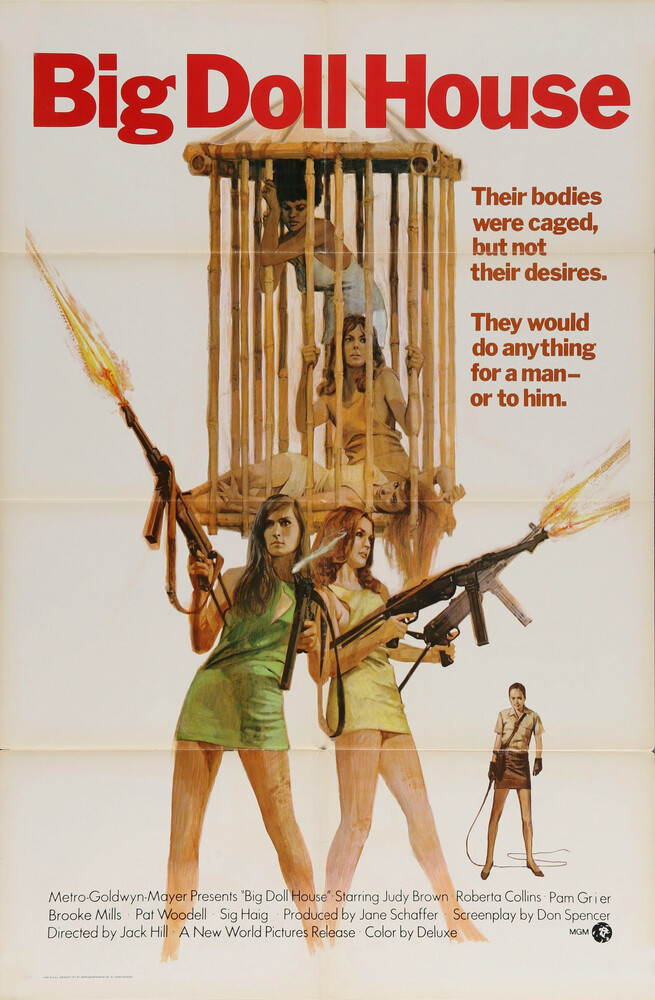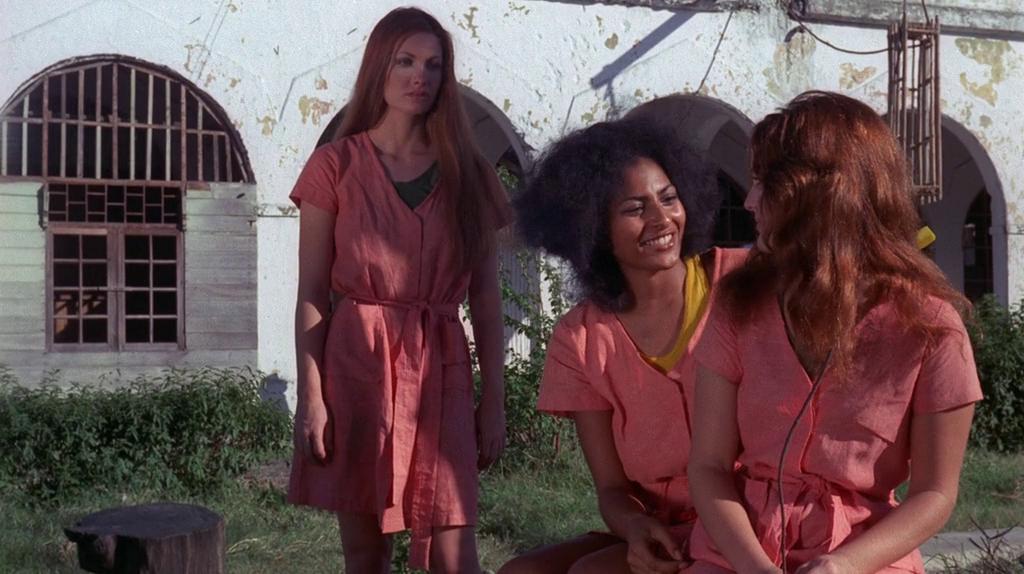Director: Jack Hill
Writer: Jack Hill
Stars: Judy Brown, Roberta Collins, Pam Grier, Brooke Mills, Pat Woodell and Sid Haig
  |
Index: The First Thirty.
If Pam Grier was hardly in Beyond the Valley of the Dolls, she more than made up for that in what could be considered her real debut, this pioneering exploitation film shot by legendary director Jack Hill for an even more legendary producer, Roger Corman.
It didn’t start the Women in Prison genre, as that had evolved over decades, from precodes focused on tough female convicts like Up the River and Ladies They Talk About, through more dedicated prison movies in the fifties such as Caged and Women’s Prison to Jess Franco’s 1969 exploitation flick, 99 Women, with Herbert Lom and Mercedes McCambridge of all people, that inspired Corman to take his own shot at it.
But, with 99 Women setting the stage, Love Camp 7 then invented the Nazi WiP subgenre and The Big Doll House invented the jungle WiP subgenre. Every successful genre spawns a set of subgenres that thrive for a while and likely fade away soon afterwards. For a while, both these dominated exploitation cinema and Pam Grier was notable in the latter.
And it all started here, with her singing the opening theme, Long-time Woman, a song that was appropriately reused in Tarantino’s Jackie Brown, given that this truly started her career and that restarted it. She shows up on screen very quickly, demonstrating character before anything actually happens and not needing a line of dialogue in order to do so.
 |
However, she’s not the lead, because that’s the new fish arriving in some unnamed prison in the Philippines. We only know that’s where we are because the film was shot there and the Government House sign is written in Tagalog; the prison has no interest in identifing itself. Anyway, that new fish is Marnie Collier who’s given 99 years hard labour for murder.
She’s a brunette played by Judy Brown, who had quite a career in the seventies, and she’s quickly thrown into a cell with five other girls. Well, not too quickly. She’s strip searched first—“Search them inside and out” commands the butch guard, Lucian. Then a bloodied corpse is carried past her on a stretcher. It doesn’t look like an easy 99 years.
Her five new cellmates are a memorable lot. Alcott is a take charge sort who introduces her to everyone. Grear is a dominant lesbian who takes charge of her in another way. Bodine is a tough revolutionary whose boyfriend Rafael is up in the hills fighting for the cause, whatever cause that happens to be. Ferina is a local girl. And Harrad is a wreck of a drug addict.
Pam Grier, playing Grear, which seems to be pure coincidence, is easily the most obvious of the bunch from moment one. She’s a little raw in her delivery, as befitting her speaking debut but she looks great, has strong presence and is clearly comfortable in whatever shoes a part is willing to put her into.
 |
Over time, as we get to know each of these girls much better, it’s Brooke Mills who shines the brightest as Harrad. This isn’t a film we’ll ever remember for its acting prowess but she gets a gift of a part and she gives it her all. She may be the least sympathetic character among the prisoners, locked up for a good reason, but she’s portrayed with depth and subtle power.
Reasons don’t really matter, of course. She’s in for killing her own baby, but the rest fit into the banana republic dictatorship background. Of course, Bodine’s in for political reasons, but Grear wasn’t locked up for being a hooker, just because a john told her too much. Even Collier had mitigating circumstances, given that her husband was doing the houseboys so she killed him before he could kill her.
However much subtext he throws in, Hill is far more interested in making this film fun, so he sets up all the things we expect nowadays from Women in Prison movies and plays them lighter than the norm would soon require.
Of course, the head guard is a butch lesbian with a fondness for torture, but Hill gives her a king cobra in a sack to lower towards victims like she’s a James Bond villain.
 |
Of course, there’s a catfight, but Hill sets up Grear vs. Alcott as a mud wrestling bout in a shallow river.
Of course, there’s a mysterious villain with a voyeurism fetish, but Hill makes him a hooded mystery with a riding crop.
And of course, there are shower scenes, but Hill has one of the few male characters in the film spy on Alcott while she’s showering, with the result that she rapes him rather than the other way round. “Get it up or I’ll cut it off!” is a priceless exploitation line.
The only serious moment that has any clear meaning is the cremation scene, of that body on the stretcher. She’s burned outside and we pan up to the chimney backed by barbed wire and can’t fail to see the parallel to Nazi death camps like Auschwitz. It’s a sobering moment in a film that otherwise aims to entertain.
And, talking of entertaining, I mentioned a man in this female prison. The only one with a need to be there ongoing is the doctor, as each of the other staff members from warden down to grunts are female. However, two other men do pop in every once in a while and Hill knows exactly how to use them to spice things up.
 |
They’re Harry and Fred, who bring produce to sell—or trade for favours—to the prisoners or guards. Jerry Franks is good as Fred, a naïve noob being shown the ropes. He’s the one who Alcott rapes, albeit not for long, because they get interrupted. However Sid Haig is glorious as Harry, the voice of experience who knows it all and may well have done a lot of it. He has a striped shirt and a thick moustache and he has fantastic chemistry with Pam Grier, which will not surprise anyone who’s seen much of either in the seventies. He’s a huge amount of fun.
The Big Doll House is a rough production with little polish. The sets are TV show level. Much of the acting is poor and things don’t move as quickly as they should. The shock reveal of the villain’s identity isn’t remotely surprising.
However, it created the template for this sort of film, from the little details to the grand sweep, which is naturally wrapped up by a big escape scene and a dose of delicious karma.
Because Grier and Haig were here for movie number one, they got brought back to do more of the same. Grier followed it up with Women in Cages, without Haig but shuffling roles with a few of her female colleagues in this picture. Then she teamed up with him for both The Big Bird Cage and Black Mama, White Mama. And I’ll be covering them all shortly!



No comments:
Post a Comment